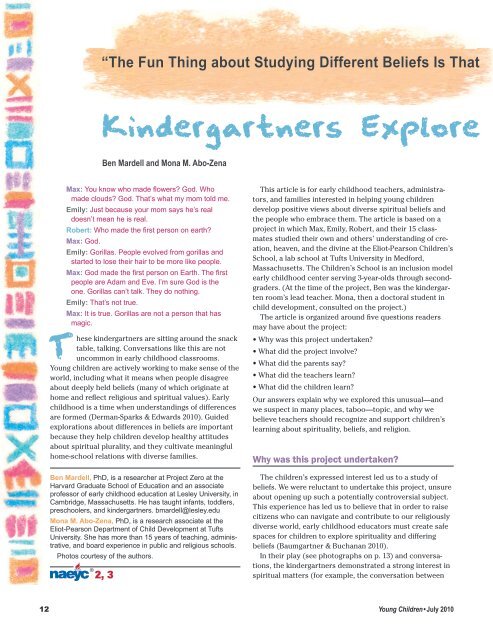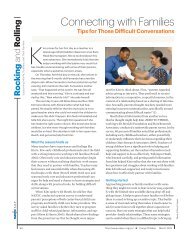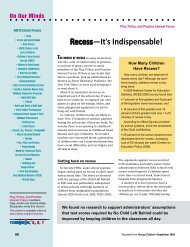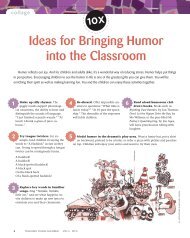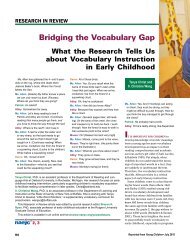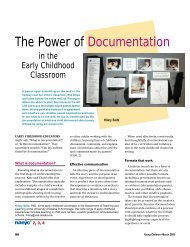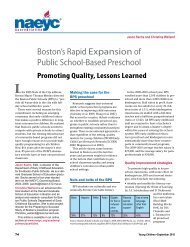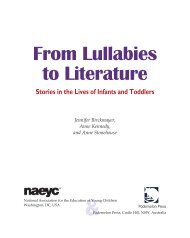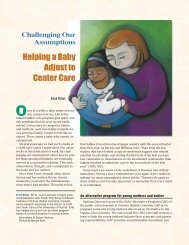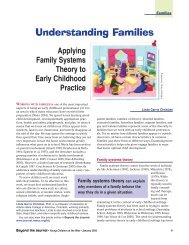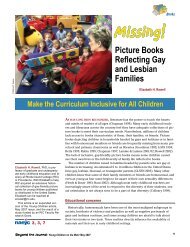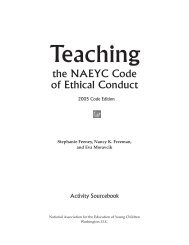Kindergartners Explore Spiritua - National Association for the ...
Kindergartners Explore Spiritua - National Association for the ...
Kindergartners Explore Spiritua - National Association for the ...
You also want an ePaper? Increase the reach of your titles
YUMPU automatically turns print PDFs into web optimized ePapers that Google loves.
T<br />
“The Fun Thing about Studying Different Beliefs Is That<br />
<strong>Kindergartners</strong> <strong>Explore</strong><br />
Ben Mardell and Mona M. Abo-Zena<br />
Max: You know who made flowers? God. Who<br />
made clouds? God. That’s what my mom told me.<br />
Emily: Just because your mom says he’s real<br />
doesn’t mean he is real.<br />
Robert: Who made <strong>the</strong> first person on earth?<br />
Max: God.<br />
Emily: Gorillas. People evolved from gorillas and<br />
started to lose <strong>the</strong>ir hair to be more like people.<br />
Max: God made <strong>the</strong> first person on Earth. The first<br />
people are Adam and Eve. I’m sure God is <strong>the</strong><br />
one. Gorillas can’t talk. They do nothing.<br />
Emily: That’s not true.<br />
Max: It is true. Gorillas are not a person that has<br />
magic.<br />
hese kindergartners are sitting around <strong>the</strong> snack<br />
table, talking. Conversations like this are not<br />
uncommon in early childhood classrooms.<br />
Young children are actively working to make sense of <strong>the</strong><br />
world, including what it means when people disagree<br />
about deeply held beliefs (many of which originate at<br />
home and reflect religious and spiritual values). Early<br />
childhood is a time when understandings of differences<br />
are <strong>for</strong>med (Derman-Sparks & Edwards 2010). Guided<br />
explorations about differences in beliefs are important<br />
because <strong>the</strong>y help children develop healthy attitudes<br />
about spiritual plurality, and <strong>the</strong>y cultivate meaningful<br />
home-school relations with diverse families.<br />
Ben Mardell, PhD, is a researcher at Project Zero at <strong>the</strong><br />
Harvard Graduate School of Education and an associate<br />
professor of early childhood education at Lesley University, in<br />
Cambridge, Massachusetts. He has taught infants, toddlers,<br />
preschoolers, and kindergartners. bmardell@lesley.edu<br />
Mona M. Abo-Zena, PhD, is a research associate at <strong>the</strong><br />
Eliot-Pearson Department of Child Development at Tufts<br />
University. She has more than 15 years of teaching, administrative,<br />
and board experience in public and religious schools.<br />
Photos courtesy of <strong>the</strong> authors.<br />
®<br />
2, 3<br />
This article is <strong>for</strong> early childhood teachers, administrators,<br />
and families interested in helping young children<br />
develop positive views about diverse spiritual beliefs and<br />
<strong>the</strong> people who embrace <strong>the</strong>m. The article is based on a<br />
project in which Max, Emily, Robert, and <strong>the</strong>ir 15 classmates<br />
studied <strong>the</strong>ir own and o<strong>the</strong>rs’ understanding of creation,<br />
heaven, and <strong>the</strong> divine at <strong>the</strong> Eliot-Pearson Children’s<br />
School, a lab school at Tufts University in Med<strong>for</strong>d,<br />
Massachusetts. The Children’s School is an inclusion model<br />
early childhood center serving 3-year-olds through secondgraders.<br />
(At <strong>the</strong> time of <strong>the</strong> project, Ben was <strong>the</strong> kindergarten<br />
room’s lead teacher. Mona, <strong>the</strong>n a doctoral student in<br />
child development, consulted on <strong>the</strong> project.)<br />
The article is organized around five questions readers<br />
may have about <strong>the</strong> project:<br />
• Why was this project undertaken?<br />
• What did <strong>the</strong> project involve?<br />
• What did <strong>the</strong> parents say?<br />
• What did <strong>the</strong> teachers learn?<br />
• What did <strong>the</strong> children learn?<br />
Our answers explain why we explored this unusual—and<br />
we suspect in many places, taboo—topic, and why we<br />
believe teachers should recognize and support children’s<br />
learning about spirituality, beliefs, and religion.<br />
Why was this project undertaken?<br />
The children’s expressed interest led us to a study of<br />
beliefs. We were reluctant to undertake this project, unsure<br />
about opening up such a potentially controversial subject.<br />
This experience has led us to believe that in order to raise<br />
citizens who can navigate and contribute to our religiously<br />
diverse world, early childhood educators must create safe<br />
spaces <strong>for</strong> children to explore spirituality and differing<br />
beliefs (Baumgartner & Buchanan 2010).<br />
In <strong>the</strong>ir play (see photographs on p. 13) and conversations,<br />
<strong>the</strong> kindergartners demonstrated a strong interest in<br />
spiritual matters (<strong>for</strong> example, <strong>the</strong> conversation between<br />
12 Young Children • July 2010
. . . They Are Different”<br />
<strong>Spiritua</strong>lity<br />
Max, Emily, and Robert). While we noted this interest from<br />
<strong>the</strong> start of <strong>the</strong> year, we initially made no ef<strong>for</strong>t to integrate<br />
it into <strong>the</strong> curriculum. Midway through <strong>the</strong> year, several<br />
children asked directly to study God. The success of <strong>the</strong><br />
ensuing God Study Group (four children who met <strong>for</strong> six<br />
weeks to pursue this interest) convinced us that it was possible<br />
to study beliefs with kindergartners.<br />
It is not just our kindergarten students who are interested<br />
in spiritual matters. Many young children are particularly<br />
curious about beliefs, making frequent reference to topics<br />
with religious and spiritual implications (Coles 1990).<br />
Because early childhood is <strong>the</strong> genesis of knowledge about<br />
and dispositions toward differences, it is a good time <strong>for</strong><br />
guided explorations of different beliefs that can help children<br />
develop healthy attitudes toward o<strong>the</strong>rs and <strong>the</strong>mselves.<br />
Curricula on religion are supported from multiple perspectives.<br />
From an academic perspective, religion is a<br />
central component of social studies. From an interfaith<br />
perspective, leaders from faith traditions have collaborated<br />
to find common ground to guide religiously inclusive<br />
school policies, practices, and curricula (Haynes, Thomas,<br />
& Ferguson 2007). From <strong>the</strong> social justice perspective,<br />
religion and religious pluralism are essential elements of an<br />
anti-bias approach. Hence <strong>the</strong> wisdom of <strong>the</strong> NAEYC Early<br />
Diverse Approaches <strong>for</strong> a Diverse Nation<br />
Childhood Program Standards and Accreditation Criteria<br />
that call <strong>for</strong> <strong>the</strong> acknowledgment and discussion of different<br />
beliefs in early childhood settings (NAEYC 2007, criteria<br />
1.A.02, 2.L.03, 7.A.02).<br />
The <strong>National</strong> Council <strong>for</strong> <strong>the</strong> Social Studies explains,<br />
“Knowledge about religions is not only characteristic of<br />
an educated person, but is also absolutely necessary <strong>for</strong><br />
understanding and living in a world of diversity” (Haynes,<br />
Thomas, & Ferguson 2007, 44). While <strong>the</strong> study of specific<br />
world religions generally occurs in middle and high school,<br />
developing <strong>the</strong> disposition of tolerance is a task <strong>for</strong> early<br />
childhood education. This is particularly important in <strong>the</strong><br />
United States, <strong>the</strong> world’s most religiously diverse nation<br />
(Eck 2002). To help our youngest citizens appreciate and<br />
understand one ano<strong>the</strong>r, we should provide safe places <strong>for</strong><br />
<strong>the</strong>m to explore spiritual beliefs and differences.<br />
Many young children are particularly<br />
curious about beliefs,<br />
making frequent reference to<br />
topics with religious and spiritual<br />
implications.<br />
What did <strong>the</strong> project involve?<br />
During <strong>the</strong> final two months of <strong>the</strong> school year, our<br />
kindergarten curriculum focuses on one topic that all <strong>the</strong><br />
children explore toge<strong>the</strong>r (to view one such capstone<br />
project, see “An Example of a Developmentally Appropriate<br />
Kindergarten Study” on <strong>the</strong> CD-ROM that accompanies<br />
<strong>the</strong> third edition of Developmentally Appropriate Practice<br />
Young Children • July 2010 13
[Copple & Bredekamp 2009]). To<br />
guide this project, we use <strong>the</strong> tool of<br />
documentation to listen carefully to<br />
children’s interests, ideas, and level<br />
of engagement to fashion developmentally<br />
appropriate activities (Katz<br />
& Chard 1989; Mardell 1999; Project<br />
Zero & Reggio Children 2000).<br />
Children generate questions, solve<br />
problems, and create collective products, participating in<br />
<strong>the</strong> “whole game of learning” (Perkins 2009).<br />
The Beliefs Project began with children drawing pictures<br />
of <strong>the</strong>ir <strong>the</strong>ories and questions (<strong>for</strong> example, Robert asked,<br />
“Why can you not see God? ’Cause God made something,<br />
but he doesn’t have hands. It’s just clear. So who made <strong>the</strong><br />
first people on <strong>the</strong> earth? God?”). The children and teachers<br />
<strong>the</strong>n discussed <strong>the</strong>se <strong>the</strong>ories and questions among<br />
ourselves, interviewed members of <strong>the</strong> school community<br />
and local experts (including a priest, imam, rabbi, and an<br />
a<strong>the</strong>ist philosopher) about <strong>the</strong>ir beliefs, listened to and <strong>the</strong>n<br />
discussed music with spiritual significance, and trans<strong>for</strong>med<br />
<strong>the</strong> dramatic play area into some children’s vision of heaven.<br />
The children shared what <strong>the</strong>y had learned with <strong>the</strong>ir families<br />
and school community by each contributing a piece to a<br />
class puzzle and describing <strong>the</strong> piece in a short video.<br />
To provide a detailed picture of our teaching practices,<br />
we focus on how <strong>the</strong> children turned <strong>the</strong> dramatic play area<br />
into heaven. The impetus to trans<strong>for</strong>m dramatic play had<br />
several sources. Play is a core resource <strong>for</strong> young children’s<br />
learning (Carlsson-Paige 2008), and <strong>for</strong> <strong>the</strong> first few weeks<br />
of <strong>the</strong> Beliefs Project, we had been wondering how to<br />
access play to support <strong>the</strong> children’s explorations. At <strong>the</strong><br />
14<br />
To help our youngest citizens<br />
appreciate and understand<br />
one ano<strong>the</strong>r, we<br />
should provide safe places<br />
<strong>for</strong> <strong>the</strong>m to explore spiritual<br />
beliefs and differences.<br />
same time, looking over video and<br />
observation notes, we realized that<br />
two children with language delays<br />
had been having difficulty participating<br />
in conversations. These two children<br />
were wonderful and committed<br />
players, so dramatic play seemed<br />
an obvious way to help <strong>the</strong>m engage<br />
in <strong>the</strong> inquiry. And all <strong>the</strong> children<br />
were interested in heaven. In <strong>the</strong>ir conversations, questions,<br />
and drawings, heaven appeared again and again.<br />
So we invited <strong>the</strong> children to create <strong>the</strong>ir vision of<br />
heaven. The process took a week and involved intentionally<br />
choreographing individual, small group, and whole<br />
class activities. To begin, six children (including <strong>the</strong> two<br />
with language delays) chose to draw <strong>the</strong>ir ideas of heaven<br />
during exploration time. After a review of <strong>the</strong> diverse ideas<br />
about heaven that <strong>the</strong> class had encountered, <strong>the</strong> children<br />
drew and chatted <strong>for</strong> 40 minutes. This in-depth experience<br />
helped <strong>the</strong> children with language difficulties articulate<br />
<strong>the</strong>ir ideas. As one explained, “I’m making it beautiful. My<br />
friend told me how heaven looks.”<br />
Children <strong>the</strong>n shared <strong>the</strong>ir ideas with <strong>the</strong>ir classmates:<br />
Larissa: This is <strong>the</strong> stairs to get up, and here’s a little slide,<br />
and you can lie<br />
down. And <strong>the</strong> curtains<br />
aren’t finished.<br />
Caroline: I think a<br />
heart would be <strong>the</strong><br />
center of heaven.<br />
Emily: I think heaven<br />
is a planet like<br />
Earth, but you can<br />
only go when you<br />
are dead. Some<br />
Young Children • July 2010
people think God is perfect, but if God is perfect, why are<br />
<strong>the</strong>re wars? I think <strong>the</strong>re is a good god and a bad god and<br />
<strong>the</strong>y fight. And sometimes one wins and sometimes <strong>the</strong><br />
o<strong>the</strong>r wins. I think heaven is nice because you should have<br />
what you want when you die. To get into heaven you climb<br />
in and slide down, like a playground. Stairs are narrow<br />
and hard to get up, so you have to be dead to go. If you’re<br />
dead, you can slide up.<br />
The next day ano<strong>the</strong>r group convened. The teacher shared<br />
<strong>the</strong> drawings and comments from <strong>the</strong> previous day to launch<br />
plans <strong>for</strong> dramatic play. The children built on <strong>the</strong> playground<br />
idea, deciding to add swings. Perhaps because of an association<br />
with hearts, it was suggested that <strong>the</strong>re be a lot of<br />
red. The group captured <strong>the</strong>ir ideas in a collective drawing,<br />
which <strong>the</strong>y shared with <strong>the</strong> whole group to get feedback.<br />
The reaction was generally positive, and additional ideas<br />
were provided (<strong>for</strong> example, <strong>the</strong> need <strong>for</strong> clouds).<br />
Work days followed. While children could come and<br />
go as <strong>the</strong>y chose, <strong>the</strong> high level of engagement with <strong>the</strong><br />
project was clear when four children asked to stay inside<br />
during recess to work on <strong>the</strong> dramatic play area. After three<br />
intensive days of construction, heaven was opened <strong>for</strong> play.<br />
It was a very popular destination.<br />
What did <strong>the</strong> families say?<br />
The parents were critical allies during <strong>the</strong> Beliefs Project.<br />
They encouraged us to pursue this inquiry, shared conversations<br />
<strong>the</strong>y were having with <strong>the</strong>ir children, and made<br />
pivotal suggestions about <strong>the</strong> project. This is not surprising.<br />
<strong>Spiritua</strong>l questions—religious and nonreligious—<br />
occupy a significant part of many adults’ thoughts. Families<br />
embraced <strong>the</strong> opportunity to engage in something so<br />
important to <strong>the</strong>ir children’s education. Of course, smooth<br />
sailing through such an emotionally charged topic was<br />
not guaranteed. The positive outcome we enjoyed was<br />
<strong>the</strong> result of ef<strong>for</strong>ts to respect and include all <strong>the</strong> families’<br />
beliefs, and <strong>the</strong> overall culture of <strong>the</strong> school.<br />
Young Children • July 2010<br />
Diverse Approaches <strong>for</strong> a Diverse Nation<br />
The teaching team invited families to participate in <strong>the</strong><br />
project even be<strong>for</strong>e its inception. As we considered undertaking<br />
this inquiry, we sent out in<strong>for</strong>mation about our<br />
intentions and invited feedback. While generally supportive,<br />
parents asked to be kept in<strong>for</strong>med and expressed <strong>the</strong><br />
desire that certain points of view be represented. During<br />
<strong>the</strong> project we issued weekly newsletters and kept a binder<br />
that charted daily activities. Parents were invited to join us<br />
in our conversations with a local priest, rabbi, imam, and<br />
philosopher, and we held several meetings to discuss <strong>the</strong><br />
directions of <strong>the</strong> project.<br />
At one of <strong>the</strong>se meetings a family raised a concern that<br />
<strong>the</strong> curriculum’s<br />
name (originally<br />
<strong>the</strong> God Project)<br />
was not inclusive; After three intensive<br />
although all fami-<br />
days of construction,<br />
lies have a belief<br />
system, not all of heaven was opened<br />
<strong>the</strong>se include a<br />
<strong>for</strong> play. It was a very<br />
belief in God or a<br />
higher being. We popular destination.<br />
acknowledged<br />
this concern, and<br />
brought it to <strong>the</strong> children. They unanimously concluded<br />
that it would be important to rename <strong>the</strong> project (to <strong>the</strong><br />
Beliefs Project) so that no one would feel left out.<br />
Family involvement in <strong>the</strong> project reflected <strong>the</strong> level of<br />
parent involvement in <strong>the</strong> school generally and <strong>the</strong> positive<br />
regard <strong>for</strong> diversity. As one mo<strong>the</strong>r reflected, “Eliot-Pearson<br />
already has a whole culture of being able to talk about<br />
differences . . . . It was very com<strong>for</strong>table <strong>for</strong> children, <strong>for</strong><br />
parents, [and] <strong>for</strong> teachers to move into this kind of conversation,<br />
to push <strong>the</strong> frontier a little fur<strong>the</strong>r. Because we<br />
were already so com<strong>for</strong>table talking about [differences].”<br />
15
As with o<strong>the</strong>r anti-bias topics,<br />
tolerance about differences in<br />
beliefs is an essential disposition<br />
<strong>for</strong> all children.<br />
Of course, it is conceivable that in o<strong>the</strong>r contexts families<br />
may be opposed to such a project. In such a situation,<br />
we recommend working to understand <strong>the</strong> nature of <strong>the</strong><br />
opposition, explaining <strong>the</strong> goals of <strong>the</strong> project (to fur<strong>the</strong>r a<br />
tolerance of different beliefs, not to teach specific beliefs),<br />
and explaining <strong>the</strong> importance of children participating in<br />
such experiences.<br />
At a reunion of <strong>the</strong> families one year after <strong>the</strong> project<br />
was completed, parents indicated that <strong>the</strong>y could not have<br />
imagined such public conversations about religious differences,<br />
because <strong>the</strong>y had been raised at a time when such<br />
discussions were taboo. They were delighted <strong>the</strong>ir children<br />
were freed from this restriction. They marveled at young<br />
children’s ability to engage in deep conversations about<br />
religion and beliefs. And <strong>the</strong>y appreciated <strong>the</strong> potential<br />
long-term impact of <strong>the</strong> project.<br />
What did <strong>the</strong> teachers learn?<br />
We learned that young children can engage in au<strong>the</strong>ntic<br />
and civil discussions about beliefs. These kindergartners<br />
were curious about <strong>the</strong>ir classmates’ beliefs. They listened<br />
attentively to <strong>the</strong> views of members of our extended community.<br />
They enjoyed trying to make sense of questions that<br />
have perplexed humanity from <strong>the</strong> beginning of time. And<br />
we learned that allowing <strong>for</strong> such conversations in <strong>the</strong> classroom<br />
can help build connections between home and school.<br />
We now believe that early childhood educators need to<br />
be proactive and intentional in incorporating issues of religious<br />
diversity into classrooms. Here, our <strong>for</strong>emost advice<br />
is to listen. We suspect that conversations that touch on<br />
religious and spiritual matters occur in classrooms with<br />
more frequency than many<br />
adults think. Teachers can model<br />
interest and tolerance, provide<br />
in<strong>for</strong>mation about <strong>the</strong> images and<br />
practices that children encounter<br />
(<strong>for</strong> example, <strong>the</strong> Madonna statue<br />
in <strong>the</strong> yard across from <strong>the</strong> school<br />
playground or why Younnis is<br />
going to be absent from school<br />
<strong>for</strong> Eid), and help clarify misconceptions<br />
about o<strong>the</strong>rs’ beliefs.<br />
Just as teachers include experiences<br />
about cultural and racial<br />
diversity in <strong>for</strong>mal curricula, teachers should consider<br />
bringing differences in beliefs into classroom conversations.<br />
The objective is to support children’s explorations<br />
of <strong>the</strong>ir own questions and learn about <strong>the</strong> perspectives of<br />
o<strong>the</strong>rs. Listening will alert teachers to <strong>the</strong> specific interests<br />
of <strong>the</strong>ir students.<br />
We acknowledge that some teachers may face greater<br />
opposition, receive less support, and feel less com<strong>for</strong>table<br />
in discussing beliefs with young children. Not everyone will<br />
feel prepared in undertaking curriculum units on beliefs.<br />
Never<strong>the</strong>less, we believe that <strong>the</strong>se conversations should<br />
occur in all early childhood settings. As with o<strong>the</strong>r anti-bias<br />
topics, tolerance about differences in beliefs is an essential<br />
disposition <strong>for</strong> all children. Teachers should encourage<br />
children to ask questions about, discuss, and explore different<br />
beliefs whe<strong>the</strong>r <strong>the</strong>y attend public or private, secular<br />
or religious schools. Parents, teachers, and administrators<br />
should discuss a range of developmentally appropriate<br />
ways to support open and curious attitudes toward different<br />
beliefs and <strong>the</strong> people who hold <strong>the</strong>m.<br />
What did <strong>the</strong> children learn?<br />
Teachers can model interest<br />
and tolerance, provide<br />
in<strong>for</strong>mation about <strong>the</strong><br />
images and practices that<br />
children encounter, and<br />
help clarify misconceptions<br />
about o<strong>the</strong>rs’ beliefs.<br />
When children are deeply engaged in a topic, <strong>the</strong>y learn<br />
in many directions at once (Project Zero & Reggio Children<br />
2000). Participation in <strong>the</strong> Beliefs Project promoted <strong>the</strong><br />
children’s problem-solving and critical-thinking abilities. It<br />
provided au<strong>the</strong>ntic experiences in using books and technology<br />
to gain in<strong>for</strong>mation, in discussing and presenting ideas<br />
in a group, and in using drawing and writing to express<br />
ideas. In Massachusetts, <strong>the</strong>se are among <strong>the</strong> language arts<br />
curriculum standards <strong>for</strong> kindergarten (Massachusetts<br />
Department of Education 2001).<br />
To conclude <strong>the</strong> project we helped <strong>the</strong> children create a<br />
video. Each child contributed a drawing of a puzzle piece<br />
with a verbal explanation of <strong>the</strong>ir thinking about beliefs.<br />
Some children discussed heaven while o<strong>the</strong>rs focused on<br />
<strong>the</strong> big bang. Regardless of <strong>the</strong> topic, each child demonstrated<br />
a high level of commitment to producing quality<br />
work. The children drew several drafts, using peer feedback<br />
to improve <strong>the</strong>ir drawings, and embraced <strong>the</strong> challenge of<br />
explaining <strong>the</strong>ir beliefs. For example,<br />
one of <strong>the</strong> children who had<br />
difficulty with expressive language<br />
explained, “I believe in heaven<br />
and God lives in my heart. He acts<br />
<strong>for</strong> all of <strong>the</strong> children, and all of<br />
our prayers. And all <strong>the</strong> animals<br />
and all <strong>the</strong> earth. We have to go<br />
to God.” Interestingly, despite this<br />
striking amount of verbal output,<br />
<strong>the</strong> child expressed dissatisfaction,<br />
saying she had not explained<br />
all she wanted to. I com<strong>for</strong>ted<br />
16 Young Children • July 2010
her, noting that beliefs are something that people think and<br />
learn about <strong>for</strong> <strong>the</strong>ir entire lives.<br />
The children also learned tolerance. At <strong>the</strong> conclusion of<br />
<strong>the</strong> project, we asked <strong>the</strong> children what <strong>the</strong>y had learned.<br />
Larissa answered, “There are many different beliefs in<br />
this school and even more beliefs in <strong>the</strong> world.” Caroline<br />
expressed her enjoyment of <strong>the</strong> study, explaining, “All of<br />
<strong>the</strong> ideas toge<strong>the</strong>r, it looked nice <strong>for</strong> Dramatic Play Heaven.<br />
I just feel like I’m having a party of everyone’s beliefs.”<br />
Max picked up on this idea, saying, “It’s something like<br />
Caroline’s. It’s like a big party of beliefs.” Having disagreed<br />
sharply with Emily about <strong>the</strong> genesis of people several<br />
months earlier, Max now explained, “The fun thing about<br />
studying different beliefs is that <strong>the</strong>y are different.”<br />
References<br />
Baumgartner, J.J., & T. Buchanan. 2010. Supporting each child’s spirit.<br />
Young Children (65) 2: 90–95.<br />
Carlsson-Paige, N. 2008. Taking back childhood: Helping your kids thrive<br />
in a fast-paced, media-saturated, violence-filled world. New York, NY:<br />
Penguin.<br />
Coles, R. 1990. The spiritual life of children. Boston, MA: Houghton<br />
Mifflin.<br />
�<br />
�<br />
�<br />
�����������������<br />
�������������������<br />
��������������<br />
����������������������������<br />
�������������������<br />
�����������������<br />
�����������������<br />
�����������������������������<br />
������������������<br />
�<br />
������������������������<br />
�<br />
�����������������<br />
�<br />
Diverse Approaches <strong>for</strong> a Diverse Nation<br />
Copple, C., & S. Bredekamp, eds. 2009. Developmentally appropriate<br />
practice in early childhood programs serving children from birth through<br />
age 8. 3rd ed. Washington, DC: NAEYC.<br />
Derman-Sparks, L., & J.O. Edwards. 2010. Anti-bias education <strong>for</strong> young<br />
children and ourselves. Washington, DC: NAEYC.<br />
Eck, D.L. 2002. A new religious America: How a “Christian country” has<br />
become <strong>the</strong> world’s most religiously diverse nation. San Francisco, CA:<br />
HarperOne.<br />
Haynes, C.C., O. Thomas, & J. Ferguson, eds. 2007. Finding common<br />
ground: A First Amendment guide to religion and public education.<br />
Nashville, TN: First Amendment Center.<br />
Katz, L., & S. Chard. 1989. Engaging children’s minds: The project<br />
approach. Norwood, NJ: Ablex.<br />
Mardell, B. 1999. From basketball to <strong>the</strong> Beatles: In search of compelling<br />
early childhood curriculum. Portsmouth, NH: Heinemann.<br />
Massachusetts Department of Education. 2001. English language arts<br />
curriculum frameworks. www.doe.mass/edu/frameworks/ela/0601.pdf<br />
NAEYC. 2007. NAEYC Early Childhood Program Standards and Accreditation<br />
Criteria: The mark of quality in early childhood education. Rev. ed.<br />
Washington, DC: Author. www.naeyc.org/torch<br />
Perkins, D. 2009. Making learning whole: How seven principles of teaching<br />
can trans<strong>for</strong>m education. San Francisco: Jossey-Bass.<br />
Project Zero & Reggio Children. 2000. Making learning visible: Children<br />
as individual and group learners. Reggio Emilia, Italy: Reggio Children.<br />
Copyright © 2010 by <strong>the</strong> <strong>National</strong> <strong>Association</strong> <strong>for</strong> <strong>the</strong> Education of Young Children.<br />
See Permissions and Reprints online at www.naeyc.org/yc/permissions.<br />
������������������������������������������<br />
������������������������������������������������������<br />
��������������������������������������������������������������������������<br />
��������������������������������������������������������������������<br />
��<br />
�<br />
�����������������������������<br />
���������������������<br />
�����������������������<br />
�����������������������<br />
�����������������<br />
�<br />
����������������<br />
������������������<br />
�����������<br />
�<br />
����������������������<br />
���������������������������<br />
��������������������������<br />
�<br />
����������������<br />
�����������������<br />
�����������<br />
�<br />
���������������������������������������<br />
�������������������������������������<br />
�<br />
��������������<br />
�������������������<br />
���������������<br />
�������������������������������������������������<br />
������������������������������<br />
Young Children • July 2010 17<br />
�


